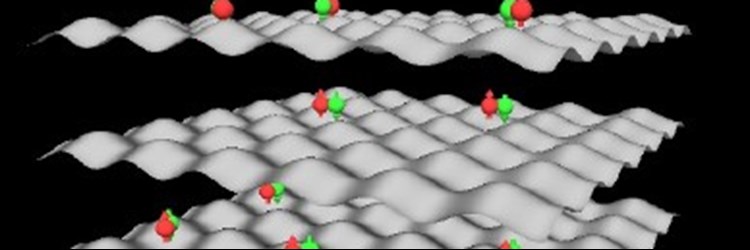
Building good approximations for the many-body state is a key issue in correlated quantum systems, particularly for Fermions where exact methods have an exponential computational cost. To this end we employ different techniques, such as:
Slave particles mean-field:
We developed different mean-field approaches, such as Gutzwiller method, the slave spins or slave bosons. These methods allow to efficiently study analytically and numerically the equilibrium and non-equilibrium properties of different strongly interacting electrons systems at a reasonably cheap computational effort.
Dynamical Mean-Field Theory (DMFT):
This is the state-of-the-art method to explore the properties of correlated systems beyond the mean-field approximation. DMFT allows to investigate the electronic response simultaneously at different energy scales, which is a key feature to understand strongly correlated materials. Suitable extensions of the method enable to investigate non-local correlations effects, non-equilibrium dynamics as well as to combine DMFT with ab-initio methods to explore quantum materials properties.
Quantum Monte Carlo:
These methods afford unbiased estimates of static ground state properties and thermal averages for most Bose systems, as well as approximate but typically very accurate estimates for fermions, with a computational cost polynomial in the system size. Since decades they set benchmarks and key reference results for fundamental models. Recent progress in devising and optimizing many-body wave functions, with intriguing overlaps with artificial intelligence techniques, open new perspectives for applications to a variety of fields including quantum chemistry, ab-initio material science, electronic excitations, strongly coupled models and real-time dynamics.
Despite its great success, the band theory of solids fails in capturing the properties of a large class of systems, e.g. transition metal oxides, heavy elements alloys, Cu-/Fe- compounds, molecular organic solids, 2D electronic gas. In facts, these systems feature the existence of a large, unscreened, electronic interaction which leads to strong correlations among carriers, i.e. electrons behave as a collective system rather than as independent particles.
The aim of our research is to understand the effects of strong electronic correlation in a variety of quantum systems, i.e. either suitable compounds or engineered solid state systems at low temperature.
Strongly correlated electrons systems:
The metal-insulator transition (MIT), i.e. the interaction driven transformation into an insulator of an otherwise partially filled metal, is the paradigm of strong correlation effects. The proximity to a MIT is universally recognized as a condition for the emergence of novel electronic phases of matter. Our goal is to understand the electronic and the optical properties of electronic systems near a Mott insulating phase, such as quantum phase transitions, coherent transport and non-linear effect, magnetic/excitonic/superconducting symmetry breaking as well as non-equilibrium ultra-fast quantum dynamics.
Correlation effects in Topological Insulators and Topological Quantum Phase-Transitions:
The topological insulators represent a novel phase of matter, characterized by short-ranged quantum entanglement and the existence of a suitable protecting symmetry. The properties of such topological states as well as the phase-transitions among them are largely affected by the presence of strong correlations. We investigate under what conditions the correlation induced change in the system ground state can alter the topological properties of the system, such as the continuous character of the topological phase-transition or the nature of the gapless boundary modes.
Excitonic states in layered systems:
A bound state of an electron and a hole, i.e. exciton, can appear in presence of a small gap between valence and conduction bands in a normal insulator. A playground for the appearance of a correlated condensed excitonic state is in near but spatially separated layers of electrons and holes, as found in coupled quantum wells or layered 2D materials. The investigation of such strong interaction effects and their interplay with system symmetries is of a great importance to understand the nature of such unconventional phase of matter, which recently has been subject to intense investigation in the field of light-matter coupling in the quantum regime.
1D bosonic systems with SOC
The possibility of achieving tunable artificial gauge field and spin-orbit coupling in cold atomic gases not only can help us to disentangle the intrinsic spin-orbit physics in more complicated systems, but it has the potential of assessing completely new phenomena. These achievements pave the way to the realization of novel topological states. We investigate models in ladder geometry that can support topological phases and which could be relevant to current experiments in ultra-cold atoms, combining numerical DMRG techniques and bosonizations analytical approach.